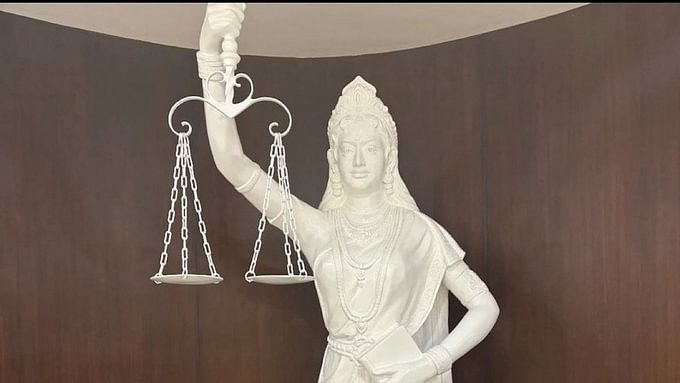
New statue of Lady Justice.
Credit: X/@airnewsalerts
The Supreme Court recently made headlines with a revamp of its symbols. A new statue of ‘Lady Justice’ was inaugurated, and shortly before, President Draupadi Murmu unveiled the Court’s new flag and insignia to commemorate its 75th anniversary. This momentous event is reminiscent of another milestone in Indian history: the unveiling of the national flag in the Indian Constituent Assembly.
On August 15, 1947, the Indian national flag, which was to be hoisted over the dome of the Constitution Hall (now known as the Central Hall of Parliament House), was presented to the Indian Constituent Assembly by an all-women committee. The adoption and presentation of the flag were the culmination of intensive deliberation and effort by the Assembly and the two committees appointed for the purpose — the Flag Adoption Committee chaired by Dr Rajendra Prasad, which finalised the design of the national flag, and the Flag Presentation Committee of 74 women under the chairmanship of Sarojini Naidu, to plan its presentation ceremony. This committee included all fifteen women members of the Assembly and also women who had contributed to political, social, and educational spheres.
Sarojini Naidu had the honour of being a member of the Flag Adoption Committee along with Maulana Azad, B R Ambedkar, K M Munshi, and C Rajgopalachari. When the resolution regarding adoption of the national flag was moved in the Constituent Assembly by Jawaharlal Nehru on July 22, 1947, out of many distinguished members who spoke on the occasion, Sarojini delivered an impassioned speech in which she recalled how multiple times during her sojourns abroad, she had felt the anguish and humiliation of not having a flag representing India. On one occasion, she was in Paris when she was asked to speak at peace celebrations on the day a peace treaty was signed at Versailles after the war—flags of all nations decorated the Opera House. That moment she strongly felt the absence of a flag of her own country: “Forty-four nations and their flags were fluttering in the great hall in which the Assembly met. I looked at the flags of all the nations, and when I spoke, I cried that, though I did not see in that great Assembly of Free Nations the flag of Free India, it would become the most historic flag of the world in the not-distant future. But here today we retrieve that sorrow and that shame: we attain our own flag, the Flag of Free India. Today we justify, we vindicate, and we salute this flag under which so many hundreds and thousands of us have fought and suffered.”
Sarojini expressed her contentment upon seeing representatives from various communities that constituted the Assembly pledge their allegiance to the flag: “Many of my friends have spoken of this flag with the poetry of their own hearts. I, as a poet and as a woman, am speaking prose to you when I say that we women stand for the unity of India. Remember this flag: there is no prince and there is no peasant; there is no rich and there is no poor. There is no privilege; there is only duty, responsibility, and sacrifice. Whether we be Hindus or Muslims, Christians, Sikhs or Zoroastrians, and others, our Mother India has one undivided heart and one indivisible spirit.”
The Assembly unanimously adopted the resolution. After its grand adoption, an equally befitting presentation of the flag was scheduled on August 14, 1947, during the midnight independence session of the Constituent Assembly. After Jawaharlal Nehru’s historical ‘Tryst of Destiny’ speech, Hansa Mehta, a member of the Constituent Assembly and a noted human rights activist, presented the national flag to the Assembly on behalf of the women of India. As Sarojini Naidu was not in Delhi on that day, Hansa was selected to do the honours. Two flags were presented on the occasion, one of khadi, which was furled on August 15, and the other of silk. Later, both were to be kept in the National Museum.
On the occasion, Hansa spoke with great delight, “I have a list here of nearly a hundred prominent women of all communities who have expressed a desire to associate themselves with this ceremonial. It is in the fitness of things that this first flag that will fly over this august House should be a gift from the women of India. It is the duty of every man and woman to preserve these traditions so that India may hold her spiritual supremacy over the world. We have fought, suffered, and sacrificed in the cause of our country’s freedom. We have today attained our goal. In presenting this symbol of our freedom, we once more offer our services to the nation.”
Renuka Ray, a fellow member of the Constituent Assembly, expressed, “At last our rights to hoist our own national flag and to stand up and sing our own national anthem had been won.”
In the past as well as present, whenever the events of national importance are marked by the presence of women, their symbolic glory is elevated to new heights, greatly signifying the dynamism in society and the nation. Even Lady Justice, now with her eyes wide open, resonates with new social and national realities and reflects enlightened vision, great change, and progression in the air.
(The writer is a historian and faculty member at Christ Church College,
Kanpur)